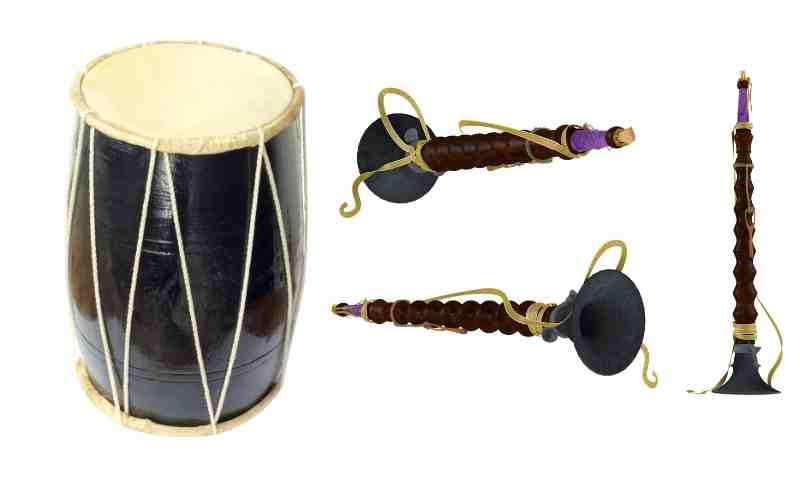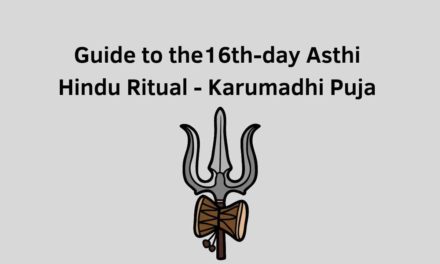The reality is that, just as beauty is in the eye of the beholder, any musical instrument may sound out of this world when played by a talented maestro. Even so, the flute is the most beautiful Indian musical instrument in my opinion, since it can convey practically any melody in a pleasant, lyrical manner. with all of its subtle intricacies still present
Hinduism is a religion in which music plays an important role. The musical instruments of the Hindu pantheon in India are closely related to the Gods and Goddesses. The flute of Krishna, the hourglass drum (damaru) of Shiva, and the Veena of Goddess Saraswati are among the most well-known.
Flute
Bansuri is the name given to the flute in Hinduism, and it is linked with the god Sri Krishna. Known as pullanguzhal in Tamil, Odakuzhal in Kerala, Mohuri in Madhya Pradesh and Chhattisgarh, Sumul in Tripura, and Siphung in Assam, the flute is a traditional instrument in the region.
The flute used in North India is far longer than the flute used in South India, particularly in Carnatic style music, and is hence more versatile. Maintaining an instrument in one’s house is considered auspicious by Hindus.
Shankh – a conch shell
The conch shell is an important component of Hinduism and its rituals and ceremonies. It is blown at temples, holy sites, and private residences during puja and festivals.
Among some Hindu groups, it is customary to blow a conch when transporting a deceased person to a burial cemetery. The conch is one of the Pancha Mahasabha instruments, which also includes a stringed instrument, the nagara, the kombu, and cymbals, among others.
Buffalo Horn is a kind of horn that may be seen on buffaloes. According to certain representations, Shiva is pictured as blowing the horn of a bull. Clay, wood, and reed whistles are among the materials used. Ancient Hindus utilized a variety of whistles, including those made of clay, wood, and reed.
Nasa Jantra – Magudi – Pungi – Nasa Jantra
This is one of the most ancient musical instruments in Hinduism, and it is particularly popular with snake charmers because of its ancient origins. In North India, this instrument is referred to as Pungi, and it is a little longer.
Because the musical instrument is sometimes blown via the nostrils, it is also known as nasa jantra (nasal jantra). Snake charmers are requested to perform with the instrument at temples, homes, and other holy locations across the world.
Jalra cymbals
Cymbals are a vital feature of Bhajans, which are the singing of songs during Hindu pujas and religious ceremonies. They are a pair of metal plates that are circular in shape. Tribal drums are known as Polidar in Tripura, talalu in Andhra Pradesh and Telangana, kinnaram in Kerala, and Talam in Tamil Nadu. Cymbals are also known as Polidar in Tripura.
Chaplas
This comprises of two wooden pieces that have been suitably formed to grasp fingers, and to which metal rings have been affixed. They come in a variety of forms and are employed to keep the music’s speed consistent. In Andhra Pradesh and Telangana, it is referred to as Bhajana Chakkalu. In Rajasthan, it is referred to as kartala.
Morsing
Morsing, also known as morchank, marachanga, or morching, is a mouth organ that is similar to the trident and is constructed of wrought iron in the shape of a trident. The index finger is used to press the instrument’s protruding neck, which causes a little robust steel strip in between two sides of the instrument to vibrate.
The device is held in between two rows of teeth on the other side of the mouth. The tongue and the breath are used to create the vibration, which is then heard.
It is also used by the aborigines of Himachal Pradesh, by the people who live in the mountainous stretches of Hyderabad, and by the people of Assam, who refer to it as gagana (gigantic).
The tondaramma, as it is known among the Chenchu tribes, is a musical instrument made from bamboo. Morsing is a kind of music that is performed in conjunction with the mridanga in Carnatic music.
Chimta – Haribol (Chimta – Haribol)
In bhajans, the instrument Chimta or Haribol is utilized. The ends of two long metal plates are joined together at one end by little metal rings that are fastened to the plates. When tapped, it produces a jangling sound, which helps to increase the speed of bhajans.
Ektara
An instrument with a single string, it is popular in Madhya Pradesh, Chhattisgarh, Jharkhand, Bihar, Maharashtra, Kashmir, and parts of Andhra Pradesh and Telangana, as well as parts of Karnataka.
Udukkai – Damaru – Udukkai
Tandava is an instrument that is associated with Lord Shiva, who used it while performing the ritual. The beating of Damaru resulted in the formation of fourteen aphorisms, which served as the foundation for the Sanskrit grammar developed by Sage Panini.
The instrument is a tiny drum with a diameter of around ten cm on both sides that is double-sided. Because the animal skin utilized is so thin, the sound of the tap is dazzling when it is turned on.
Pakhavaj
Similar to the Mridangam, this instrument is mostly employed in North India and is similar in appearance. It is used as an accompaniment to Kathak dance, religious melodies, and dhrupad-style singing, amongst other activities.
Khol
Another popular drum that is utilized in dancing performances, kirtanas, and devotional music is the conga drum. Bengal, Jharkhand, Assam, and Manipur are among the states that are well-known for this instrument.
Among the cylinder, instruments are the mridangam, the pakhavaj, and the khol. The cylindrical design of the instrument, which is built of wood and wrapped on both sides with processed animal leather, allows for a wide range of tones that are much superior than those produced by other instruments.
There is a direct relationship between the length of the log of wood and the thickness of the black circle, as well as the distance between the two sheaths of skin, and the resonance.
Dholak – Dhol is a kind of dhol
On one side, a stick is used to beat the dough. It is often seen in temples. The beat’s sound is often quite loud, allowing it to be heard from a considerable distance away. In Madhya Pradesh, a form of Dhol is played by striking it with two sticks.
Veena
The veena is a centuries-old instrument. Many Hindu writings make mention of it, including the Vedas. Sage Yajnavalkya, who is referenced in the Vedas, was a skilled player of the Veena, according to legend.
Tambura
When it comes to Indian music, this stringed instrument is the most important piece of equipment to have on hand. This is mostly for the purpose of maintaining the drone and tonic of the song. Despite its resemblance to the Veena, it lacks frets as well as the little kalasam and instead has four strings with birada.
Villadivadyam
In this arrangement, a bamboo bow is fastened to a wooden base, with thin metal balls hanging from both ends of the bow. Music is generated when a bow string is tapped with two little wooden sticks, which are held together by thread. It is utilized at festivals.
Ghatam
It’s just a plain clay pot without a cover on it. Playing the instrument requires use of both hands, wrists, all 10 fingers, and even the nails. The pot’s mouth is forced against the stomach, and the strokes applied at the neck, the middle, and the bottom of the outside surface generate a range of tones.
Nagara
This is a large old drum with a long history. In order to make a thunderous sound that can be heard from a considerable distance, the player bangs the drum with two wooden sticks, which are held together by ropes. It is beaten to signal the arrival of a temple deity in procession. During the giving of food to the god, it is also beaten.
Panchamukha Vadyam (Panchamukha Vadyam)
Nowadays, it is quite unusual to see one. The instrument is composed of five little drums that are fixed around the circumference of the large drum. The drummer alternates between all five drums, each of which represents a distinct tala.
Tavil – Melam
Along with the Nadaswaram, this barrel-shaped drum is also played on the stage. Right-handed players use the wrist and capped fingertips, whereas left-handed players use a large stick to make their strikes. It is performed on auspicious occasions, such as weddings and temple festivals, as well as during religious ceremonies.
Vichitra Veena
The instrument is similar in appearance to the normal veena, with the exception that there are no frets in the stem. While the musician plucks the strings with his right index finger, he rolls a stone roller over the strings with his left hand. The sound generated by this instrument is quite different from that of the veena.
Kuzhitalam
a round bronze plate with a tiny depression in the middle, which is held in the left hand, hanging, and tapped with a stout wooden stick as seen here. Kerala is a state where it is practiced.
Villukottu
These musical instruments are crafted from the coconut’s boat-shaped sepal. A thin bamboo weed is connected to both ends of a bamboo stick, which is then tapped with the bamboo stick.
Pampai
It consists of two brass drums that are held together and played at festivals and other auspicious events throughout the country. Each of the two drums is linked to the other drum. With a stick on one end and a hand on the other, one ends up being hit.
Tase and Bidi
These are little drums that are shaped like shallow bowls and are often constructed of wood, clay, or metal, however, they may also be made of other materials. A leather strap or a rope is used to bind the animal skin across the front of the jacket.
For the game, a pair of sticks is required. Depending on its size, it is either thrown around the neck or thrown on the ground on its side. Devotional singers and wedding procession participants make use of the instruments on stage.
Budabudukkah
Budabudukkah is a little half-glass-shaped drum that is usually utilized by the madari, also known as the monkey man. In the middle of the drum are strung with knots connected, and the player hits the drum on both sides of the drum to make a loud rattling sound.
Tokka
Tokka is made of a bamboo tube that is around 90 centimeters in length. The bottom end has been carved out in such a manner that it may be used as a handle of sorts. In one hand, it is grasped, while the other hand beats it on the palm of the other. If you prefer another method, you may shake the tube until the slit faces rub up against one another.
Dhenjung
It is constructed from a series of little bamboo pipes that are linked together with a rope. In order to create music, the musician drapes the instrument over his neck and alternatively taps the pipes with a cane stick.
Champurana
This instrument is constructed from a single piece of wood that has been hollowed out. There is a long cylindrical resonator across which three strings are strung, one of which is gut and the other two of which are steel.
Songkong
The songkong is a huge instrument with a body 11 meters in length and a circumference of around 4 meters in diameter. It is distinguished by the presence of a booming sound. When it comes to the Nagas of Nagaland, it is employed as a means of signaling.
Chirki
The horn of an ox is used to construct this musical instrument. A wooden stick is tapped on the inside of the mouth, which produces a loud sound. The mouth is covered with animal skin.
Srunai
It is a Shehnai from the Kashmir region. One tube with an integrated bell makes up the whole structure. The bore is likewise conical, with seven finger holes and one thumb hole in the back, as well as a conical bore in the front.
Tumbaknari
Essentially, it is a kind of drum in the form of a long-necked water pot with the bottom knocked off and wrapped with skin. With the right hand, it is held under the left arm and played with the left hand.
Santur
Santur’s origins may be traced back to the Vedic vana vina, which is claimed to have had 100 strings of pun grass and was played with sticks, and which was played with sticks. This satatantri veena, which has 100 strings, has been transformed into a santur.
Vanso or Jodeparvo
It is common among cowherds in Gujarat to use this instrument, which is held horizontally. Each of the two pieces is crafted from bamboo or wood. There is a hole at one end of the structure that has been blasted. Each flute has four holes for creating a melody, and both flutes are set to the same pitch, which makes for a beautiful sound.
Nagphani
Nagphani is a musical instrument that is utilized in Gujarati and Rajasthani traditional music. It is composed of a bronze cylindrical tube with a bell-shaped aperture and a beautiful metal tongue, into which the mouthpiece has been inserted for added visual interest.
Nagada
This instrument may be seen in temples and dancing performances across the world. The hemispherical bowl is composed of iron and has a hemispherical form. A hoop is used to secure the parchment to the body. The animal skin is tightened by the hoop at the rim. The resonant sound is produced by striking the instrument with a tiny wooden stick.
Naubat
With paper held in place by hoops and laced to the bodies of the bowls, this instrument is equivalent in size and weight to the other. The pitches of the two drums are not the same. It is utilized in many dances and festivals across the world.
Bagilu
It is a single-stringed instrument that is utilized for the production of beats. There is a resonator that is made out of parchment. Under the parchment is a gut string with a knob attached to it. The other end of the string is threaded through a resonator and attached to a little wooden pole for stability.
Chibara
This is a stringed instrument from the Indian state of Madhya Pradesh. The musical instrument is constructed from a single block of wood that has been blessed. Three primary steel strings are attached to the bottom of the instrument and are coupled to the tuning pegs at the top. They are played using a bow constructed of a curved cane stick with jingle bells attached, which is pushed against the board by the fingertips of those who play them.
Tantar
Wooden frets are strung together to form a single long piece of furniture. Two gourds of identical size and shape are strung together to form the body. Using a bow that is composed of a bent bamboo pole and hair that is linked to jingle bells, the musician plays the instrument.
Manjira
It’s a pair of little metallic cymbals with a metallic finish. An elastic cord or cotton thread is used to link the flat circular discs of manjira together, with the cord or thread going through a hole in the middle of each disc. It is used as a background track for religious music across India.
Dangal
This is constructed from two tiny bowls, one of which is covered by thin iron plates and the other which is covered by a copper plate. A minor difference in size between the bowls gives each of them a particular tala (shape). Naggarchi are the individuals who play the instrument in Rajasthan, and they are called as such.
Ravanhatta
In Rajasthan, it is a widely used traditional instrument. Its origins may be traced back to the Ravanastra, which is a mythological creature associated with Ravana, the ruler of Lanka, according to the Ramayana. Using a semi-coconut shell that has been polished and wrapped with skin, the Ravanhatta’s resonator is created.
A bamboo resonator is attached to the resonator using screws. The bamboo is strung with two major strings, one of which is made of horsehair and the other of which is made of steel. In order to play the instrument, the bow is whacked against these strings. Small bells, known as ghungru, are connected to the bow in order to create a jingling effect when the player plays.
Tabala
Tabala has its origins in the ancient Puskara drums of India, which are still in use today. A hand-held puskara is seen in a number of temple sculptures. Drummers seated with two or three different miniature drums in their hands, their palms and fingers in a posture similar to that of playing the drums, may be seen in a variety of sculptures.
The concept of puskara is explored in the Natyashastra.
Sarod
The chitra veena of ancient India is credited with the invention of the sarod. A coin from the Gupta dynasty portrays King Samudragupta playing an instrument that is said to be the forerunner of the Sarod.
Aside from the above-mentioned instruments, some other musical instruments associated with Hinduism in India include the alghoza, suriyapirai, candrapirai, vezha thakkil, tambourin, bulbultara, pushkaram, guntalam, tondai, tumlaknari, dilo, and swarbat. Other musical instruments associated with Hinduism include the dilo and the swarbat. The Sitar is a modified version of the Veena.





